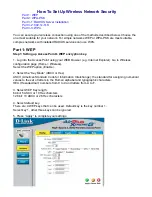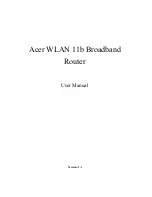
© Copyright 2017 TRENDnet. All Rights Reserved.
TRENDnet User’s Guide
TEW-740APBO / TEW-740APBO2K
47
WMM Parameters of Access Point : This affects traffic flowing from the access
point to the client station
Queue
Data
Transmitted
AP to Clients
Priority
Description
AC_BK Background.
Low
High throughput. Bulk data that requires maximum
throughput and is not time-sensitive is sent to this
queue (FTP data, for example).
AC_BE
Best Effort
Medium
Medium throughput and delay. Most traditional IP
data is sent to this queue
AC_VI
Video
High
Minimum delay. Time-sensitive video data is
automatically sent to this queue
AC_VO
Voice
High
Time-sensitive data like VoIP and streaming media
are automatically sent to this queue
Configuring QoS options consists of setting parameters on existing queues for different
types of wireless traffic. You can configure different minimum and maximum wait
times for the transmission of packets in each queue based on the requirements of the
media being sent. Queues automatically provide minimum transmission delay for
Voice, Video, multimedia, and mission critical applications, and rely on best-effort
parameters for traditional IP data.
As an Example, time-sensitive Voice & Video, and multimedia are given effectively
higher priority for transmission (lower wait times for channel access), while other
applications and traditional IP data which are less time-sensitive but often more data-
intensive are expected to tolerate longer wait times.
o
Aifsn: The Arbitration Inter-Frame Spacing Number specifies a wait time (in
milliseconds) for data frames
o
CWmin: Minimum Contention Window. This parameter is input to the algorithm
that determines the initial random back-off wait time ("window") for retry of a
transmission. The value specified here in the Minimum Contention Window is the
upper limit (in milliseconds) of a range from which the initial random back-off
wait time is determined.
o
CWmax: Maximum Contention Window. The value specified here in the
Maximum Contention Window is the upper limit (in milliseconds) for the doubling
of the random back-off value. This doubling continues until either the data frame
is sent or the Maximum Contention Window size is reached. Once the Maximum
Contention Window size is reached, retries will continue until a maximum
number of retries allowed is reached. Valid values for the "cwmax" are 1, 3, 7, 15,
31, 63, 127, 255, 511, or 1024. The value for "cwmax" must be higher than the
value for "cwmin".
o
Txop: Transmission Opportunity is an interval of time when a WME AP has the
right to initiate transmissions onto the wireless medium (WM). This value
specifies (in milliseconds) the Transmission Opportunity (TXOP) for AP; that is, the
interval of time when the WMM AP has the right to initiate transmissions on the
wireless network.
o
ACM: Admission Control Mandatory, ACM only takes effect on AC_VI and AC_VO.
When you do not click Checkbox, it means that the ACM is controlled by the
connecting AP. If you click Checkbox, it means that the Client is in charge.
o
AckPolicy: Acknowledgment Policy, WMM defines two ACK policies: Normal ACK
and No ACK. Click “Checkbox” indicates “No ACK”
When the no acknowledgment (No ACK) policy is used, the recipient does not
acknowledge received packets during wireless packet exchange. This policy is
suitable in the environment where communication quality is fine and interference
Queue
Data
Transmitted
Clients to AP
Priority
Description
AC_BK
Background.
Low
High throughput. Bulk data that
requires maximum
throughput and is not time-
sensitive is sent to this queue
(FTP data, for example).
AC_BE
Best Effort
Medium
Medium throughput and delay.
Most traditional IP data is
sent to this queue
AC_VI
Video
High
Minimum delay. Time-sensitive
video data is automatically
sent to this queue
AC_VO
Voice
High
Time-sensitive data like VoIP
and streaming media are
automatically sent to this
queue
Summary of Contents for TEW-740APBO
Page 1: ...TRENDnet User s Guide Cover Page ...
Page 93: ......
















































